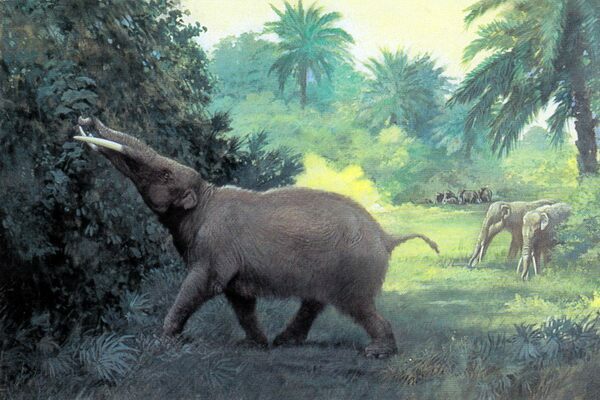This Specimen has been sold.
4.9" Partial Gomphothere (Mastodon Relative) Molar - South Carolina
This is a partial, 4.9" long fossilized molar of a Gomphothere, a relative of the Mastodon. It was collected fromm a river in South Carolina by a diver searching for Megalodon teeth.
About Gomphotherium
Gomphotherium was an extinct genus of elephant-like creatures that lived from the Miocene to Pleistocene Epochs (about 13.6 million to 1.7 million years ago). It had a wide distribution across Africa, Europe, Asia, and North America, and was an ancestor of modern elephants. Unlike today's elephants, Gomphotherium had tusks in both its upper and lower jaws, with the lower tusks being shovel-shaped, likely used for digging or feeding on vegetation.
Standing around 10 feet tall and weighing up to 6 tons, Gomphotherium inhabited various environments, from wetlands to forests. Its fossils, found worldwide, have helped paleontologists understand the evolution of proboscideans, a group that includes elephants and mammoths. Although it eventually went extinct due to climate change and competition, Gomphotherium remains a key figure in studying elephant evolution.
Fossil evidence indicates that Gomphotherium inhabited a wide variety of environments, from forests to grasslands and wetlands. Its broad distribution across continents suggests it was a highly adaptable creature capable of thriving in different climates and ecosystems.
Gomphotherium likely led a semi-aquatic lifestyle in some regions, similar to that of hippos today, given the shovel-shaped lower tusks, which could have been ideal for scooping up aquatic vegetation. In forested areas, it may have used its tusks and trunk to browse on leaves and bark. Its omnivorous diet helped it survive across varying environments, from dense forests to open plains.
Gomphotherium holds a crucial place in the evolutionary history of elephants. While not a direct ancestor of modern elephants, it is part of the same family tree. Gomphotherium’s tusks and trunk are examples of early adaptations that later evolved into the characteristics seen in today's elephants.
The genus also highlights the incredible adaptability of proboscideans. Over millions of years, various branches of this family have adapted to different environmental challenges, resulting in the evolution of several species, including the woolly mammoth, mastodon, and the elephants we know today.
Gomphotherium was an extinct genus of elephant-like creatures that lived from the Miocene to Pleistocene Epochs (about 13.6 million to 1.7 million years ago). It had a wide distribution across Africa, Europe, Asia, and North America, and was an ancestor of modern elephants. Unlike today's elephants, Gomphotherium had tusks in both its upper and lower jaws, with the lower tusks being shovel-shaped, likely used for digging or feeding on vegetation.
Standing around 10 feet tall and weighing up to 6 tons, Gomphotherium inhabited various environments, from wetlands to forests. Its fossils, found worldwide, have helped paleontologists understand the evolution of proboscideans, a group that includes elephants and mammoths. Although it eventually went extinct due to climate change and competition, Gomphotherium remains a key figure in studying elephant evolution.
Fossil evidence indicates that Gomphotherium inhabited a wide variety of environments, from forests to grasslands and wetlands. Its broad distribution across continents suggests it was a highly adaptable creature capable of thriving in different climates and ecosystems.
Gomphotherium likely led a semi-aquatic lifestyle in some regions, similar to that of hippos today, given the shovel-shaped lower tusks, which could have been ideal for scooping up aquatic vegetation. In forested areas, it may have used its tusks and trunk to browse on leaves and bark. Its omnivorous diet helped it survive across varying environments, from dense forests to open plains.
Gomphotherium holds a crucial place in the evolutionary history of elephants. While not a direct ancestor of modern elephants, it is part of the same family tree. Gomphotherium’s tusks and trunk are examples of early adaptations that later evolved into the characteristics seen in today's elephants.
The genus also highlights the incredible adaptability of proboscideans. Over millions of years, various branches of this family have adapted to different environmental challenges, resulting in the evolution of several species, including the woolly mammoth, mastodon, and the elephants we know today.
SPECIES
Cuvieronius tropicus
AGE
LOCATION
South Carolina
SIZE
4.9" long
CATEGORY
SUB CATEGORY
ITEM
#235817
We guarantee the authenticity of all of our specimens.
 Reviews
Reviews













